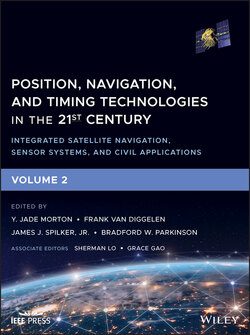Читать книгу Position, Navigation, and Timing Technologies in the 21st Century - Группа авторов - Страница 34
36.3.10 Strengths and Weaknesses of Approaches
ОглавлениеIn this chapter, we have presented three classes of nonlinear recursive estimation algorithms. While each algorithm offers improved performance over the linear and extended Kalman filter in the presence of nonlinearities and non‐Gaussian systems, it is important to address the “strengths and weaknesses” of each. To accomplish this, we evaluate each estimation from this perspective, starting with the traditional approaches.
Figure 36.19 SIR particle filter state estimate (after 100 observations). Note that the state estimate is almost completely unimodal and has converged to the correct integer ambiguity.
Figure 36.20 SIR particle filter position error and one‐sigma uncertainty. Note that the error uncertainty collapses once sufficient information is available to resolve the integer ambiguity.
As expected, each approach has a set of associated strengths and weaknesses that can greatly influence the results for a given problem. Thus, the choice of estimator must be considered carefully based on the characteristics of the problem at hand. In cases where the constraints of the problem do not readily fit into the generalized categories above, there are many examples of hybrid estimation schemes that seek to synergistically combine the desirable properties of multiple estimator types. While it is beyond the scope of this chapter to explore the range of hybrid filtering approaches, the interested reader is referred to the references (e.g. [4, 5, 6, 9, 10]) for foundational concepts.
